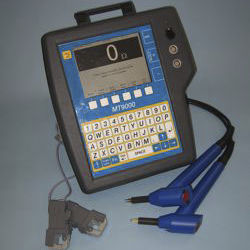
- Production - Materials - Metrology
- Test equipment - Metrology
- Dielectric crack detector
- Advanced Analysis & Integration Limited
Dielectric crack detector MM10 for aeronautics
Add to favorites
Compare this product
Characteristics
- Technology
- dielectric
- Applications
- for aeronautics
Description
MM10 Digital Measurement System
Despite the increased use of composite materials and adhesives in aircraft, the majority of aircraft parts are still held together with rivet-type fasteners.
To install a fastener, a riveting machine drills a hole in the workpieces to be secured. The hole is countersunk and a fastener is placed in the hole, the head of the fasteners are then ground to give a flat surface finish.
To ensure a quality joint, it is important that the fastener be placed at the proper depth in the workpiece. If the countersink is too deep, the rivet joint ultimately created could be weakened and subject to corrosion. If the countersink is too shallow, the head can create aerodynamic drag.
To reduce the risk of error AAI have developed the MM10 unit.
The MM10 records the fastener head deviation from the aerostructure skin surface and performs statistical and mathematical calculations on the resulting data. The information is used to adjust the settings on riveting equipment and can be downloaded for quality assurance purposes.
The MM10 communicates with a range of gauge types via a standard RS232 communications link and can be linked to any digital gauge with an RS232 communications port. (Software modifications may be required).
As an example Airbus UK use the MM10 to optimise the settings of their Electroimpact
automated riveting machines. The machines automatically drill and countersinks holes and inserts rivets which must be flush fitted to the aircraft skin, minimising drag and improving
aerodynamic efficiency.
Catalogs
Other Advanced Analysis & Integration Limited products
Products
*Prices are pre-tax. They exclude delivery charges and customs duties and do not include additional charges for installation or activation options. Prices are indicative only and may vary by country, with changes to the cost of raw materials and exchange rates.



